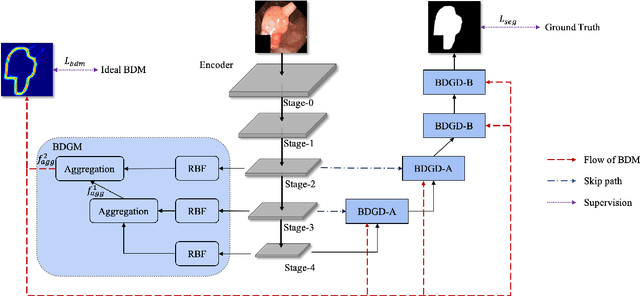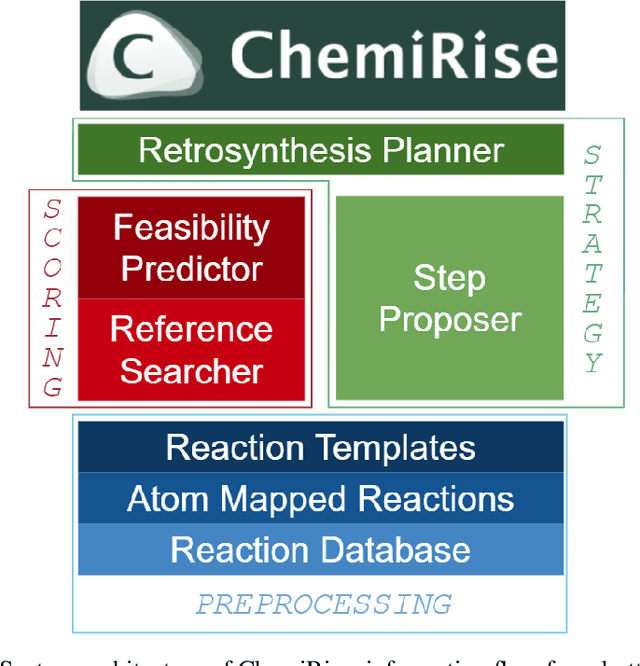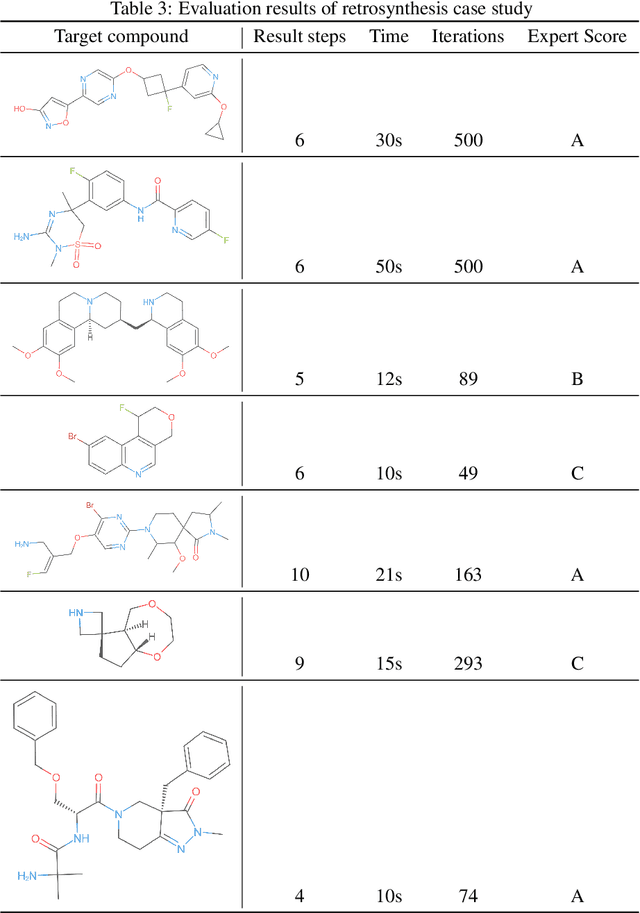Jie Fan
Accutar Biotechnology
Object-level Correlation for Few-Shot Segmentation
Sep 09, 2025Abstract:Few-shot semantic segmentation (FSS) aims to segment objects of novel categories in the query images given only a few annotated support samples. Existing methods primarily build the image-level correlation between the support target object and the entire query image. However, this correlation contains the hard pixel noise, \textit{i.e.}, irrelevant background objects, that is intractable to trace and suppress, leading to the overfitting of the background. To address the limitation of this correlation, we imitate the biological vision process to identify novel objects in the object-level information. Target identification in the general objects is more valid than in the entire image, especially in the low-data regime. Inspired by this, we design an Object-level Correlation Network (OCNet) by establishing the object-level correlation between the support target object and query general objects, which is mainly composed of the General Object Mining Module (GOMM) and Correlation Construction Module (CCM). Specifically, GOMM constructs the query general object feature by learning saliency and high-level similarity cues, where the general objects include the irrelevant background objects and the target foreground object. Then, CCM establishes the object-level correlation by allocating the target prototypes to match the general object feature. The generated object-level correlation can mine the query target feature and suppress the hard pixel noise for the final prediction. Extensive experiments on PASCAL-${5}^{i}$ and COCO-${20}^{i}$ show that our model achieves the state-of-the-art performance.
Axiomatizing Rumsfeld Ignorance
Jul 22, 2025Abstract:In a recent paper, Kit Fine presents some striking results concerning the logical properties of (first-order) ignorance, second-order ignorance and Rumsfeld ignorance. However, Rumsfeld ignorance is definable in terms of ignorance, which makes some existing results and the axiomatization problem trivial. A main reason is that the accessibility relations for the implicit knowledge operator contained in the packaged operators of ignorance and Rumsfeld ignorance are the same. In this work, we assume the two accessibility relations to be different so that one of them is an arbitrary subset of the other. This will avoid the definability issue and retain most of the previous validities. The main results are axiomatizations over various proper bi-frame classes. Finally we apply our framework to analyze Fine's results.
* This is an almost-final version
The Role of Rank in Mismatched Low-Rank Symmetric Matrix Estimation
Jul 16, 2025Abstract:We investigate the performance of a Bayesian statistician tasked with recovering a rank-\(k\) signal matrix \(\bS \bS^{\top} \in \mathbb{R}^{n \times n}\), corrupted by element-wise additive Gaussian noise. This problem lies at the core of numerous applications in machine learning, signal processing, and statistics. We derive an analytic expression for the asymptotic mean-square error (MSE) of the Bayesian estimator under mismatches in the assumed signal rank, signal power, and signal-to-noise ratio (SNR), considering both sphere and Gaussian signals. Additionally, we conduct a rigorous analysis of how rank mismatch influences the asymptotic MSE. Our primary technical tools include the spectrum of Gaussian orthogonal ensembles (GOE) with low-rank perturbations and asymptotic behavior of \(k\)-dimensional spherical integrals.
Position: Simulating Society Requires Simulating Thought
Jun 08, 2025Abstract:Simulating society with large language models (LLMs), we argue, requires more than generating plausible behavior -- it demands cognitively grounded reasoning that is structured, revisable, and traceable. LLM-based agents are increasingly used to emulate individual and group behavior -- primarily through prompting and supervised fine-tuning. Yet they often lack internal coherence, causal reasoning, and belief traceability -- making them unreliable for analyzing how people reason, deliberate, or respond to interventions. To address this, we present a conceptual modeling paradigm, Generative Minds (GenMinds), which draws from cognitive science to support structured belief representations in generative agents. To evaluate such agents, we introduce the RECAP (REconstructing CAusal Paths) framework, a benchmark designed to assess reasoning fidelity via causal traceability, demographic grounding, and intervention consistency. These contributions advance a broader shift: from surface-level mimicry to generative agents that simulate thought -- not just language -- for social simulations.
Toward Aligning Human and Robot Actions via Multi-Modal Demonstration Learning
Apr 14, 2025



Abstract:Understanding action correspondence between humans and robots is essential for evaluating alignment in decision-making, particularly in human-robot collaboration and imitation learning within unstructured environments. We propose a multimodal demonstration learning framework that explicitly models human demonstrations from RGB video with robot demonstrations in voxelized RGB-D space. Focusing on the "pick and place" task from the RH20T dataset, we utilize data from 5 users across 10 diverse scenes. Our approach combines ResNet-based visual encoding for human intention modeling and a Perceiver Transformer for voxel-based robot action prediction. After 2000 training epochs, the human model reaches 71.67% accuracy, and the robot model achieves 71.8% accuracy, demonstrating the framework's potential for aligning complex, multimodal human and robot behaviors in manipulation tasks.
A Simplified Algorithm for Joint Real-Time Synchronization, NLoS Identification, and Multi-Agent Localization
Dec 17, 2024



Abstract:Real-time, high-precision localization in large-scale wireless networks faces two primary challenges: clock offsets caused by network asynchrony and non-line-of-sight (NLoS) conditions. To tackle these challenges, we propose a low-complexity real-time algorithm for joint synchronization and NLoS identification-based localization. For precise synchronization, we resolve clock offsets based on accumulated time-of-arrival measurements from all the past time instances, modeling it as a large-scale linear least squares (LLS) problem. To alleviate the high computational burden of solving this LLS, we introduce the blockwise recursive Moore-Penrose inverse (BRMP) technique, a generalized recursive least squares approach, and derive a simplified formulation of BRMP tailored specifically for the real-time synchronization problem. Furthermore, we formulate joint NLoS identification and localization as a robust least squares regression (RLSR) problem and address it by using an efficient iterative approach. Simulations show that the proposed algorithm achieves sub-nanosecond synchronization accuracy and centimeter-level localization precision, while maintaining low computational overhead.
Towards Real Zero-Shot Camouflaged Object Segmentation without Camouflaged Annotations
Oct 22, 2024Abstract:Camouflaged Object Segmentation (COS) faces significant challenges due to the scarcity of annotated data, where meticulous pixel-level annotation is both labor-intensive and costly, primarily due to the intricate object-background boundaries. Addressing the core question, "Can COS be effectively achieved in a zero-shot manner without manual annotations for any camouflaged object?" we affirmatively respond and introduce a robust zero-shot COS framework. This framework leverages the inherent local pattern bias of COS and employs a broad semantic feature space derived from salient object segmentation (SOS) for efficient zero-shot transfer. We incorporate an Masked Image Modeling (MIM) based image encoder optimized for Parameter-Efficient Fine-Tuning (PEFT), a Multimodal Large Language Model (M-LLM), and a Multi-scale Fine-grained Alignment (MFA) mechanism. The MIM pre-trained image encoder focuses on capturing essential low-level features, while the M-LLM generates caption embeddings processed alongside these visual cues. These embeddings are precisely aligned using MFA, enabling our framework to accurately interpret and navigate complex semantic contexts. To optimize operational efficiency, we introduce a learnable codebook that represents the M-LLM during inference, significantly reducing computational overhead. Our framework demonstrates its versatility and efficacy through rigorous experimentation, achieving state-of-the-art performance in zero-shot COS with $F_{\beta}^w$ scores of 72.9\% on CAMO and 71.7\% on COD10K. By removing the M-LLM during inference, we achieve an inference speed comparable to that of traditional end-to-end models, reaching 18.1 FPS. Code: https://github.com/R-LEI360725/ZSCOS-CaMF
Fast Gradient Computation for Gromov-Wasserstein Distance
Apr 13, 2024



Abstract:The Gromov-Wasserstein distance is a notable extension of optimal transport. In contrast to the classic Wasserstein distance, it solves a quadratic assignment problem that minimizes the pair-wise distance distortion under the transportation of distributions and thus could apply to distributions in different spaces. These properties make Gromov-Wasserstein widely applicable to many fields, such as computer graphics and machine learning. However, the computation of the Gromov-Wasserstein distance and transport plan is expensive. The well-known Entropic Gromov-Wasserstein approach has a cubic complexity since the matrix multiplication operations need to be repeated in computing the gradient of Gromov-Wasserstein loss. This becomes a key bottleneck of the method. Currently, existing methods accelerate the computation focus on sampling and approximation, which leads to low accuracy or incomplete transport plan. In this work, we propose a novel method to accelerate accurate gradient computation by dynamic programming techniques, reducing the complexity from cubic to quadratic. In this way, the original computational bottleneck is broken and the new entropic solution can be obtained with total quadratic time, which is almost optimal complexity. Furthermore, it can be extended to some variants easily. Extensive experiments validate the efficiency and effectiveness of our method.
BDG-Net: Boundary Distribution Guided Network for Accurate Polyp Segmentation
Jan 03, 2022



Abstract:Colorectal cancer (CRC) is one of the most common fatal cancer in the world. Polypectomy can effectively interrupt the progression of adenoma to adenocarcinoma, thus reducing the risk of CRC development. Colonoscopy is the primary method to find colonic polyps. However, due to the different sizes of polyps and the unclear boundary between polyps and their surrounding mucosa, it is challenging to segment polyps accurately. To address this problem, we design a Boundary Distribution Guided Network (BDG-Net) for accurate polyp segmentation. Specifically, under the supervision of the ideal Boundary Distribution Map (BDM), we use Boundary Distribution Generate Module (BDGM) to aggregate high-level features and generate BDM. Then, BDM is sent to the Boundary Distribution Guided Decoder (BDGD) as complementary spatial information to guide the polyp segmentation. Moreover, a multi-scale feature interaction strategy is adopted in BDGD to improve the segmentation accuracy of polyps with different sizes. Extensive quantitative and qualitative evaluations demonstrate the effectiveness of our model, which outperforms state-of-the-art models remarkably on five public polyp datasets while maintaining low computational complexity.
ChemiRise: a data-driven retrosynthesis engine
Aug 09, 2021



Abstract:We have developed an end-to-end, retrosynthesis system, named ChemiRise, that can propose complete retrosynthesis routes for organic compounds rapidly and reliably. The system was trained on a processed patent database of over 3 million organic reactions. Experimental reactions were atom-mapped, clustered, and extracted into reaction templates. We then trained a graph convolutional neural network-based one-step reaction proposer using template embeddings and developed a guiding algorithm on the directed acyclic graph (DAG) of chemical compounds to find the best candidate to explore. The atom-mapping algorithm and the one-step reaction proposer were benchmarked against previous studies and showed better results. The final product was demonstrated by retrosynthesis routes reviewed and rated by human experts, showing satisfying functionality and a potential productivity boost in real-life use cases.
 Add to Chrome
Add to Chrome Add to Firefox
Add to Firefox Add to Edge
Add to Edge